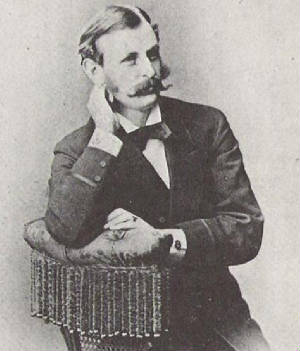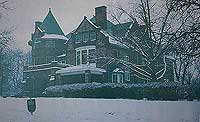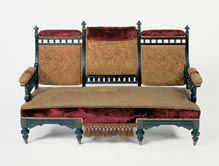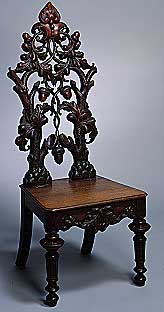 |
 |
|

|
| Richard H. M. (1850-1925) |
Richard (1850-1925) my great grandfather
Richard was the son of Robert and Harriet Hannaford, born in Cincinnati, Ohio. He joined his father's company, the Rammelsberg
Furniture Company. By 1894, Richard was secretary of the company.
He married Mary Lucia Lincoln on 14 Jun 1871. She was known to family as Pearl. Born in Cincinnati, she was the daughter
of prominent attorney Timothy Danielson Lincoln and Mary Snelling Clarke.
They lived in a large hilltop estate in Avondale, OH, near Cincinnati, which he named "Enniskillen" inherited from
Robert.
They donated it to the Archdiocese of Cincinnati who sold it to a Montessori school (click on the image below). It is located
near the end of Mitchell Ave, at 3 Burton Woods Lane Cincinnati, OH 45229.


|
| Click for recent history of house on the National Register of Historic Places |
Donald C. Peirce in his article "Rammelsberg: Cincinnati Furniture Manufacturers 1847-1881" in Winterthur Portfolio
13 wrote that the firm catered to both high- and low-end buyers. "The mass production and distribution methods used by
Rammelsberg had enabled the firm to manufacture and sell great quantities and enormous varieties of furniture, as surviving
pieces of furniture and the firm's 1863 and 1864 wholesale price lists illustrate. The 1863 price list included sixty-three
different categories of furniture and 483 patterns. Nearly 71 percent of the offerings were priced at $30 or less.
Peirce noted that comparing inventory and price lists revealed that great quantities of lower-priced goods were kept in
stock and more expensive items were made to order. The furniture ranged "from the plainest to the most elegant and fashionable."
In 1854 an English visitor to the firm wrote that the factory was "as large as a Manchester cotton-mill, five stories
high, where 260 hands are constantly employed in making chairs, tables, and bedsteads." Those workers were primarily
Americans and Germans, "the English and Scotch being rejected on account of their intemperance," wrote the English
visitor.
According to Witherell, "The firm employed thirty-six carvers, and judging by the quality of execution and design
of this hatrack and reception chair they were indeed capable of producing extraordinary work. While the case was manufactured
with machine assistance, the openwork would have required substantial hand finishing." The hatrack is rare, said Witherell,
not only for its quality, early date, and firmly documented maker, but also because of its carving and naturalistic ornamentation.
In 1849 the works were rebuilt on a larger scale, but when they were ready to start business was very much depressed, and
then to add to the depression came the cholera epidemic. They struggled on, however, and continued adding to their capacities
until they finally triumphed by having built up a good trade. When the Civil war broke out they were employing between four
and five hundred men. This calamity again depressed the business, but in a few years it began to pick up again, and in time
it became quite flourishing. The working force was increased from five hundred to six hundred men, and as business increased
it was still further added to until a much larger number was employed. In 1871-72 the present store and manufactory-100x150
feet, six stories in height in front and seven in the rear was built, being one of the largest establishments of the kind
in the United States. At present they manufacture and set up wooden mantels, which they have introduced into Cincinnati and
which have largely displaced stone and iron mantels in many of the best residences. They also make a specialty of interior
fittings of all kinds for offices, banks, hotels, court and state houses, as well as private residences. A wholesale as well
as a retail department is conducted. The entire floorage of the factories and store covers nearly ten acres of space. In 1867
Mr. Mitchell incorporated the concern as the "Mitchell & Rammelsberg Furniture Company" and took in a number
of the employes as stockholders, but reserved the first right to repurchase the stock if they desired to dispose of it, which
he did at the request of the holders some years since.
|
 |
|
In its first one hundred years, Cincinnati evolved from an isolated frontier outpost to one of the nation’s leading
commercial centers. At the forefront of the American Industrial Revolution, the city flourished due to its location on the
Ohio River. Between the 1780s and the 1850s, there were few towns in the United States which offered as many commercial opportunities
as Cincinnati. During this period, Cincinnati quickly grew as a center for trade and commerce, and by 1859, the city was among
the largest industrial centers in the United States, second only to Philadelphia. The Queen City manufacturers were among
the leading producers of pork, machinery, clothing, soap and candles, boots and shoes, whiskey, ales, books, and printed materials.
This rise of industry in the Queen City also led to the development of art industries like furniture, silver, and ceramics.
The furniture industry in Cincinnati started soon after the city was incorporated, established as early as the 1820s and 1830s
by artisans like James Reed and William Hawkins. The furniture created in the city during this period reflects a desire for
stylish, high-quality goods. By mid-century Cincinnati had become one of the leading centers for furniture manufacturing in
the Unites States with 120 furniture manufacturers employing 2,850 workers by 1859. The early availability of steam power
and machinery in the city greatly changed the business character of the furniture industry and increased the amount of wares
produced and sold. The Mitchell & Rammelsberg furniture Company, established in 1847, was one of the largest furniture companies
in Cincinnati.

Mitchell and Rammelsberg Furniture Co.
(1847-1881)
United States (Cincinnati)
Sofa, 1876-81
Ebonized wood, upholstery
40 1/2 x 65 x 29 in.
(102.9 x 165 x 73.7 cm)
Henry Meis Endowment, 1987.63.1
Part of a six-piece parlor suite, this sofa was manufactured by Mitchell and Rammelsberg, Cincinnati's premier furniture
company in the nineteenth century. The company's original paper label still adheres to the underside of the seat on each of
the four side chairs, and the original upholstery fabric is still intact. The suite is in the modern Gothic style, which was
popular in this country in the last quarter of the nineteenth century. The Aesthetic movement jacquard fabric of the upholstery
was inspired by exotic patterns from Eastern textiles.
Mitchell and Rammelsberg owed its success to numerous factors. The company used modern technology such as steam-powered
machines to cut its manufacturing costs; it offered a wide range of styles including Renaissance revival, Queen Anne, Japanese,
Egyptian revival, and neoclassical; it produced a variety of high-quality furniture forms for the home or office and offered
them at a variety of prices; and it was located in a prosperous city with a rapidly growing population. By the 1870s, the
firm had opened branch retail stores in St. Louis, Memphis, and New Orleans as well as a six-story retail building in Cincinnati's
fashionable retail district.
In addition to supplying home and office furniture, Mitchell and Rammelsberg sold furnishings for hotels, stores, churches,
and schools. The company retailed furniture, upholstery, and other household accessories made by other American and European
manufacturers as well as its own wares. Mitchell and Rammelsberg displayed its furniture at the 1876 Philadelphia Centennial
Exhibition, where it was highly praised.
Rammelsberg was among the first in Cincinnati to adopt steam-powered machines. Its early success resulted in the opening of
branch stores in St. Louis, Memphis, and New Orleans. By the 1870s the Cincinnati business included a vast factory complex
and an impressive six-story retail building in the city's fashionable Fourth Street retail district. The company continued
in business until the 1930s.
|
|
 |
|
Robert (1811-1899) my great great grandfather
Cincinnati's Pioneer Furniture Magnate

ROBERT, son of John and Jane (Peterson), was born in the North of Ireland in 1811, and came to this country with his parents
in 1824. The family having settled on a wild farm in Indiana, Robert had to bear his share of the hardships incident to pioneer
life. He is the fourth of ten children.
Robert Mitchell came from Enniskillen, Ireland along with his family. They settled in the western wilderness of Franklin,
Indiana in 1824. Mitchell arrived in Cincinnati in 1829 at the age of 18 with no money. He apprenticed to different cabinetmakers.
Before that time, Mitchell had various employments: farm hand, country school teacher and odd jobs handyman. He earned $1/week
from the cabinetmaker and Mitchell opened his own store in 1836. His first partner was with Cincinnati Mayor Robert Moore.
Moore also was born in Ireland and was a chair maker by trade.
The three Mitchell brothers, Robert, William and John, were partners. John was a bedstead and wholesale chair manufacturer,
sometimes in partnership with Robert. He stayed in the wholesale chair business from 1851 to 1877, when he retired. Frederick
Rammelsberg bought up Moore’s shares to become Mitchell’s partner in 1846-47.
Frederick Rammelsberg (1814-1863) was born in Hanover, Germany. The family came to America in 1830 and both of his parents
died in 1833 of cholera. His name first appeared in Cincinnati in 1836 and he entered into a furniture making partnership
with Seneca Jones in 1838. While this partnership lasted until 1845, it is the firm of Mitchell & Rammelsberg begun in 1846
that still is remembered by furniture collectors today. Both men contributed $10,000 for their joint venture.
A fire in 1848 that destroyed their factory brought them to the verge of ruin since the loss was total and they weren’t
insured. But they were able to borrow enough money to rebuild. By 1850, Mitchell & Rammelsberg reported in the U.S. census
that their venture had a value of $145,000. This included 400,000 feet of oak, rosewood, ash, maple, poplar, pine, cherry
and walnut worth $8,5000; 100,000 feet of veneers worth $4,000 and 14,000 feet of mahogany appraised at $2,500.
What made this furniture company so successful? Rammelsberg was the first local furniture manufacturer to use machinery on
a large scale, turning out interchangeable parts. By using the steam driven machinery for the heavy work, huge quantities
of furniture could be turned out. The hand work was used in the final finishing stages. Furniture, chairs, mirrors, cabinet
ware and cornices were turned out en masse for not only the retail trade, but for furnishing of steamboats as well. To sell
this much furniture, the company moved aggressively into retailing.
Cincinnati was a major center for the furniture trade due to its location. In 1881, the Cincinnati Board of Trade and Transportation
secretary, J. F. Blackburn said: “Cincinnati is situated with the cherry and walnut regions of the South on one side,
and the populous consuming region of the North and Northwest on the other side. Cherry and other native woods are coming into
favor, and the imported wood, mahogany, is also rapidly coming into use...The tendency of competition has been to cut off
the ragged edges of the manufacture from Cincinnati, and leave her manufacturers masters of the field in the production of
the finer, more tasteful and costly articles, as well as the better grades of a medium style of furniture.” The virgin
forests of the Midwest provided the golden oak that was so popular in Victorian homes. The demand for oak furniture was great
in England because of a disease that killed off the English oak trees. Another factor for the Cincinnati based furniture businesses
was the Ohio River, for transportation and the power to run factories. Cincinnati had at one time 150 such furniture factories.
The wholesale warehouses and factory were on both sides of Second and John Streets. Most of the furniture manufacturers were
clustered around Second Street where they were close to lumberyards, railroads and river transportation. Mitchell & Rammelsberg
had the largest furniture factory in the world. All the footage of showrooms and the factories amounted to five acres. By
splitting the locations of various stages in the manufacturing process, the danger from a fire was minimized. There were 80
wood working, steam driven machines. In the 1870’s, 750 men were employed. The lumber yard alone covered two acres.
According the Charles Cist (1851): Mitchell & Rammelsberg are about to introduce a bedstead of novel construction, for which
they have the exclusive manufacturing right in this market. The improvement made is by connecting the rail to the post by
a dovetail, thus dispensing entirely with screws, and enabling the bedstead to be put up and taken down in less than five
minutes; which of course, affords great facilities to the removal of this article from house to house, or room to room, and
of readily taking them out in case of fire.
Kenny’s Illustrated Cincinnati, 1875, states: “The retail salesrooms are well worth visiting. The traveler will
probably not see in any city in Europe or America such a rare collection of fine articles on the furniture line as may be
seen on the second floor of the establishment on Forth Street. The firm imports costly works of art, which are distributed
through their rooms. They manufacture furniture for ‘the million,’ from the commonest table and chair to the finest
suites for parlor, drawing room, library, bedroom, or dining room that can be furnished. Robert Mitchell, President; A. H.
Mitchell, Secretary and Treasurer.”
The retail showrooms were in the six story Mitchell Company building on West Fourth Street, designed in 1873 by James Keys
Wilson in the popular Renaissance Revival style. Wilson was also the architect for the Plum Street Temple and the entrance
gate for Spring Grove Cemetery. The Mitchell Company building is still standing as the central portion of the late McAlpin’s
store on Fourth street. This section is marked by the stone carving of a woman’s head surmounting an arch. When the
building was constructed, its next door neighbor was John Shillito’s dry goods store. When Mitchell first came into
Cincinnati, he helped to dig the foundation for the Second Presbyterian Church, which was the site of his new furniture showroom.
The Fourth Street store had the latest innovations. An elevator carried shoppers from floor to floor and merchandise was displayed
in sample room settings. A complete line of accessories was available so a customer could choose new curtains, mattresses
and even fireplace mantels at the same time. Their largest consumers were other businesses, including hotels and banks.
In 1870 an industry census lists annual sales as $700,000. The 600 employees (550 men, 10 women, 40 children) made furniture
from three million feet of lumber.
Rammelsberg died in 1863, at age 49,
Although Mitchell bought out the Rammelsberg shares, he kept the partnership name until 1881. The focus of the firm changed
then to emphasize store interiors, architectural elements and office furniture.
Robert Mitchell was joined in his business by his two sons, Albert H. and Richard H. Robert Mitchell married Harriet Hannaford
and had eight children. Mitchell Avenue is named for Robert Mitchell who built a mile long street that opened into new homes
being built in Mitchell’s Rose Hill Park subdivision. Like many wealthy men, Mitchell invested in real estate. He planned
this subdivision with winding streets and large front lawns. Some of the homes built belonged to Mitchell, Andrew Erkenbrecher
and Samuel Pogue.
Mitchell’s “French Chateau” style mansion was built by the architect Samuel Hannaford in 1893. The workers
and some of the materials were said to have come from Germany. The house was given to the Catholic Archdiocese in the 1920’s
and served as St. Thomas School. In 1970 the property became the Montessori “New School.”
Robert Mitchell died in 1899 and the business, then known as the Robert Mitchell Furniture Company, declined.
Robert Mitchell and Frederick Rammelsberg (1814-1863) each kicked in $10,000 and founded the firm Mitchell & Rammelsberg in
1847 in Cincinnati, Ohio. According to Witherell, Mitchell was responsible for merchandising stores and general business,
while Rammelsberg supervised the factory production. Over the next three decades, the firm became one of the most successful
and largest furniture manufacturers in the country.
Robert was first married in 1838, and a second time in 1864.
He was always in the shop with his workmen and ever took a deep interest in their welfare. When the company was incorporated
he was chosen president, but retired from any active participation in the business, choosing to leave its direction in the
hands of his sons and son-in-law. The family attend Grace Episcopal Church, Avondale, Robert was a member of the first I.
O. O. F. Lodge organized in Cincinnati, and such for many years.
|
|
|
|

